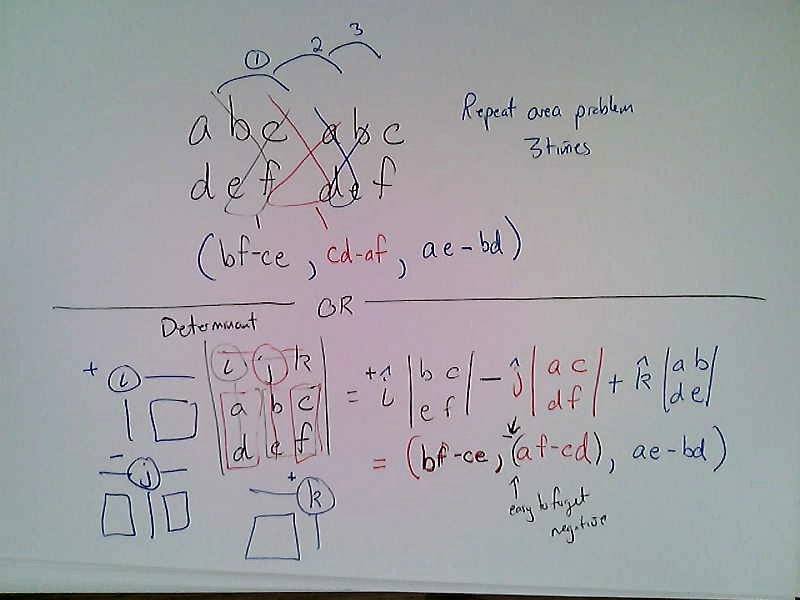


- What motivates people?
Solution

Rapid Recall
Most of the questions today require a very short answer. I'd like you to focus on just giving the missing pieces, rather than trying to write down the entire problem. We'll do several of these in rapid succession (you can review all the details for the ones you want to) after class.
- Fill in the blanks below, using the substitution $u=x^2$: $$\int_{3}^{7}xe^{x^2}dx = \int_{\_}^{49}e^{u}(\_)du .$$
Solution
$$\int_{3}^{7}xe^{x^2}dx = \int_{9}^{49}xe^{u}(\frac{1}{2x})du .$$
- Fill in the missing pieces below: $$\int_{0}^{3}\int_{0}^{\sqrt{9-x^2}}x dydx=\int_{?}^{?}\int_{?}^{?}(?)(?)drd\theta.$$
Solution
$$\int_{0}^{3}\int_{0}^{\sqrt{9-x^2}}x dydx=\int_{0}^{\pi/2}\int_{0}^{3}(r\cos\theta)(r)drd\theta.$$
- The points $P=(1,2,3)$ and $Q=(x,y,z)$ lie in a plane. A normal vector to this plane is $\vec n = (4,5,6)$. Give a single number for the dot product $\vec {PQ}\cdot \vec n$, in other words fill in the question mark below. $$4(x-1)+5(y-2)+6(z-3)=?$$
Solution
The vectors $\vec {PQ}$ and $\vec n$ are orthogonal so their dot product is zero. This gives $$4(x-1)+5(y-2)+6(z-3)=0,$$ which is an equation of the plane containing $P$ with normal vector $\vec n$.
- (Mentally complete - don't write the answer as it would take forever) For the curve $\vec r(t)=(4t^2, 5t-1,t^3)$, the velocity is $\vec v(t) =(8t,5,3t^2)$ and speed is $v(t) = \sqrt{(8t)^2+(5)^2+(3t^2)^2}$. A wire lies along this curve for $1\leq t\leq 4$, and has density function given by $\delta = xy$. Set up an integral that gives $\bar y$.
$$\bar y = \frac{\int_1^4(?)(?)(?)dt}{\int_1^4(?)(?)dt}$$
Solution
Remember that $ds = vdt = \sqrt{(8t)^2+(5)^2+(3t^2)^2} dt$. We compute $$\begin{align} \bar y &=\frac{\int_C y dm}{\int_C dm}\\ &=\frac{\int_C y \delta ds}{\int_C \delta ds} \\ &=\frac{\int_C y (xy) ds}{\int_C (xy) ds} \\ &=\frac{\int_1^4 (5t-1) (4t^2(5t-1)) \sqrt{(8t)^2+(5)^2+(3t^2)^2} dt}{\int_1^4 (4t^2(5t-1)) \sqrt{(8t)^2+(5)^2+(3t^2)^2} dt}. \end{align} $$
- For the change of coordinates $x = 2u+3v$ and $y=4u+5v$ we have $$\begin{pmatrix}dx\\dy\end{pmatrix} = \begin{pmatrix}2\\4\end{pmatrix}du+\begin{pmatrix}3\\5\end{pmatrix}dv.$$ What is the Jacobian of this transformation, in other words fill in the blank below: $$\iint_{R_{xy}} dxdy = \iint_{R_{uv}}(?)dudv.$$
Solution
The Jacobian is the area of the parallelogram formed by the partial derivatives $(2,4)$ and $(3,5)$, namely $J=\dfrac{\partial(x,y)}{\partial(u,v)} = |2\cdot 5-3\cdot 4| = 2$. This means $$\iint_{R_{xy}} dxdy = \iint_{R_{uv}}(2)dudv.$$
- Find a nonzero vector that is orthogonal to both $(a,b,c)$ and $(d,e,f)$.
Solution
The cross product gives $(bf-ce, cd-af,ae-bd)$. Here are some ways to remember it.

Group problems
Please use the following sheet to let me know where your group is at in the problems.
- Compute $\ds \int_{0}^{4}\int_{8}^{2x}e^{y^2}dydx$. [Hint: Swap the order of integration first.]
- Draw the region described the bounds of each integral. (Remember you can use a Mathematica notebook Integration.nb to check your work.)
- $\ds\int_{0}^{3}\int_{0}^{9-x^2}\int_{0}^{3-x}dzdydx$
- $\ds\int_{0}^{1}\int_{0}^{1-z}\int_{0}^{\sqrt{1-x^2}}dydxdz$
- $\ds\int_{0}^{3}\int_{0}^{\pi}\int_{0}^{5}rdzd\theta dr$
- $\ds\int_{-1}^{1}\int_{0}^{1-y^2}\int_{0}^{x}dzdxdy$
- For each region below, (1) set up a double integral that gives the area of the region. Feel free to use any coordinate system you want. Then set up a formula to compute $\bar x$, the $x$ coordinate of the centroid.
- The region in the first quadrant of the $xy$-plane that lies above the line $y=x$ and below the semicircle $y=\sqrt{16-x^2}$.
- The region in the first quadrant that lies below the line that passes through the two points $(4,0)$ and $(0,6)$.
- For each solid region below, (1) set up a triple integral that gives the volume of the region. Then set up a formula to compute $\bar z$, the $z$-coordinate of the centroid of the region.
- The solid hemiball of radius 3, above the $xy$-plane.
- The solid region in the first octant that lies under the paraboloid $z=9-x^2-y^2$.
- Set up an integral formula to compute each of the following:
- The mass of a disc that lies inside the circle $x^2+y^2=9$ and has density function given by $\delta = x+10$
- The $x$-coordinate of the center of mass (so $\bar x$) of the disc above.
- The $z$-coordinate of the center-of-mass (so $\bar z$) of the solid object in the first octant (all variables positive) that lies under the plane $2x+3y+6z=6$.
- The $y$-coordinate of the center-of-mass (so $\bar y$) of the same object.
|
Sun |
Mon |
Tue |
Wed |
Thu |
Fri |
Sat |
